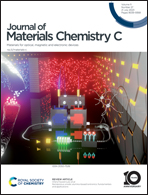Mn2+-doped organic–inorganic hybrids (C8H20N)2Zn1−xMnxBr4 as sub-micrometer green phosphors for Mini-LEDs/Micro-LEDs†
Abstract
Green light conversion materials with small particle sizes and high luminous quality are essential for high-resolution display technology, such as Mini-LEDs and Micro-LEDs. Here, we demonstrate an effective strategy to prepare a sub-micrometer green phosphor via doping Mn2+ in a small-sized organic–inorganic hybrid Zn(II) bromide (C8H20N)2ZnBr4. Among a series of prepared (C8H20N)2Zn1−xMnxBr4 (x = 0–1.0), (C8H20N)2Zn0.7Mn0.3Br4 showed a particle size of around 700 nm, an emission peak centered at 517 nm with a full width at half maximum of 47 nm, a photoluminescence quantum yield of about 80%, and a stabilized photoluminescence intensity with a slight increase under continuous UV-light illumination over a 30 day test range. A [MnBr4]2− tetrahedron was effectively split by a massive tetraethylammonium cation (C8H20N)+ and [ZnBr4]2− tetrahedron unit in the zero-dimension structure, which was considered responsible for reducing the electron–phonon coupling of Mn2+, accelerating the leap process of [MnBr4]2−, and enhancing the optical and thermal stability of emitting centers. These results indicated that (C8H20N)2Zn0.7Mn0.3Br4 is a valuable candidate for Mini-LEDs and Micro-LEDs.



 Please wait while we load your content...
Please wait while we load your content...